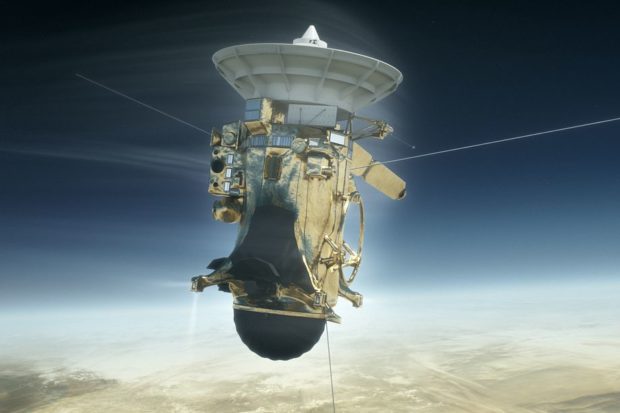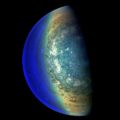After almost 13 years of zooming around Saturn and many of its moons, NASA’s Cassini spacecraft will be no more on Friday . Friday morning, Cassini will dive into Saturn’s atmosphere, eventually melting and breaking and destroying itself apart. The plunge to death will end the spacecraft’s mission, one that has shown us so much about Saturn and its moons than we ever knew before . So may cool photos and a lot of data.
This final step has long been planned by the Cassini mission team to protect the Saturn system. Two of the planet’s moons — Enceladus, with its subsurface ocean, and Titan, with lakes of methane — may have the right conditions to harbor life. By destroying Cassini, NASA ensures the spacecraft will never accidentally wander near the moons and contaminate them with microbes that may have been carried along from earth and may be catastrophic if they enter the moon.
In April, NASA maneuvered Cassini into its final stage, known as the “Grand Finale” — a path that takes the vehicle between Saturn and its famous rings, and closer to the planet than ever before. During these week-long orbits, the probe has been gathering some of its most crucial data yet. But the planet’s gravity will eventually get the best of Cassini after the 22nd Grand Finale orbit, pulling the spacecraft into the planet at 6:31AM ET on Friday. “The navigators have no more maneuvers to do,” Scott Edgington, the deputy project scientist for Cassini, tells The Verge. “We’re guaranteed to go into Saturn, no matter what happens.”
Once Cassini enters Saturn’s atmosphere, it will only be five or six minutes before the probe is taken apart. During the plunge, its instruments will be getting up-close measurements that will be sent back to Earth in real time. All that data will probably keep researchers busy for awhile. “Some of these analyses will take years for scientists to figure out,” says Edgington. “I would expect to still hear a lot more from Cassini in the coming years.”
Cassini’s destruction has been in the making for nearly a decade now. The spacecraft was launched in 1997, and it was the first probe intended to orbit and thoroughly study the Saturn system. After arriving at the planet in 2004, Cassini dropped a probe that landed on Titan, and began mapping out Saturn’s rings and moons, among many other science tasks. After four years, Cassini’s primary mission ended. But the spacecraft was still fully operational, and the mission team wanted to come up with ways to extend Cassini’s time at Saturn while preserving Enceladus and Titan. It couldn’t last forever: the spacecraft only has a limited amount of fuel, and eventually the team would lose the ability to maneuver Cassini in space.
o the team came up with a number of different options: one idea was to eject Cassini from the Saturn system, but that wasn’t exactly popular. “Of course, the scientists were like, ‘No, we’re orbiting Saturn. We have a perfectly healthy spacecraft. We want to explore Saturn more!’” says Edgington. Another option was to put Cassini into a distant orbit around Saturn, so the vehicle wouldn’t encounter Titan and Enceladus for 500 years, avoiding the risk of contaminating them. And then there was the option of bringing Cassini closer to Saturn, where it could continue flying by the planet’s moons for years and eventually fly between the ring gap — in other words: the Grand Finale. “You should have seen the eyes of the scientists,” says Edgington. “They were like kids in a candy store. They were delighted to hear this because it allowed us to do new science that we couldn’t do before.”
ut the ultimate byproduct of the Grand Finale will be Cassini’s demise. During these final trips around Saturn, the spacecraft has repeatedly passed close to Titan, and the moon’s gravity has been slightly altering the vehicle’s path. This week, Cassini will pass by Titan again, and the encounter will put the probe on its crash course with Saturn. “We’re calling it a goodbye kiss,” says Edgington. “Titan will steal just enough energy from our orbit to send us right into Saturn’s atmosphere on September 15th.”
Cassini will try to observe as many things as possible before it goes down, including Enceladus, Titan, and Saturn’s rings and atmosphere. Then, a few hours before the plunge, Cassini will roll into its dive position: pointing its antenna at Earth while positioning some of its instruments toward Saturn’s atmosphere. This way, the vehicle can collect as much data as possible during the fall, while rapidly sending the info back to Earth.
After that, there’s not much left to do but wait for Cassini’s signal to end. The spacecraft will be hitting the molecules in Saturn’s atmosphere at supersonic speeds, which will create a lot of friction and heat. Eventually, the temperatures will be so high that pieces of the spacecraft will start to break away and the vehicle will stop sending signals back to Earth. The loss won’t be confirmed until 90 minutes after the spacecraft’s destruction. Cassini’s radio signal takes a while to reach our planet, since the spacecraft is more than 700 million miles away. “By the time we’re watching for this signal to end, the spacecraft would have already been destroyed,” says Edgington.
Friday will mark the end of an era: Cassini has been such an extraordinary tool for learning about Saturn and its moons. The probe helped to confirm the existence of a potentially habitable subsurface ocean on Enceladus. It’s also showed that Titan has rivers and lakes created by rain, just like on Earth. What Cassini gathers on its dive may lead to even more discoveries, too, but it’s still going to be an emotional time.
“A lot of us have spent a lot of time on this project and we’re just in love with Saturn and its system and the spacecraft itself,” says Edgington. “And here we are: it’s not going to exist after next week. It’s going to be bittersweet and I can imagine a lot of tears being shed after that final signal is lost.”
credit : THEVERGE




